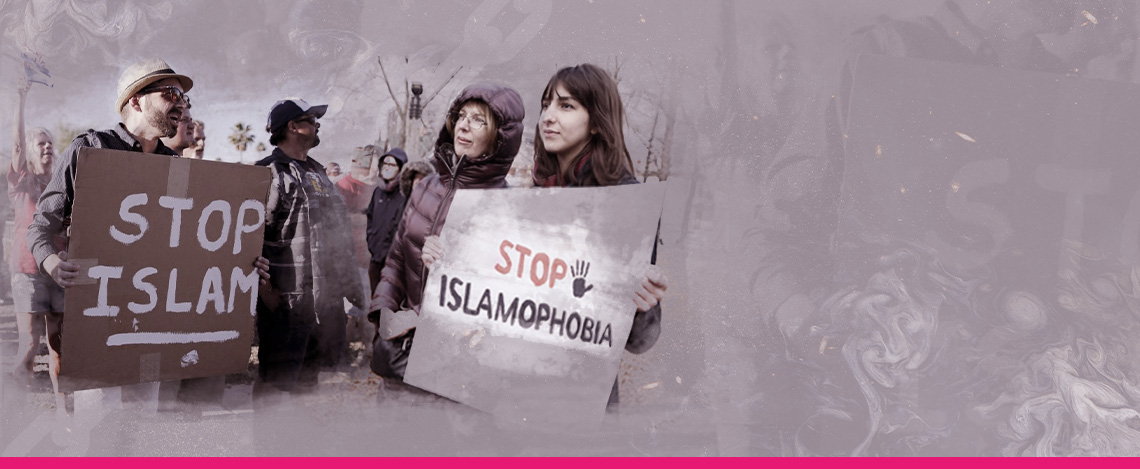The Islamophobia crisis in Europe : A reading in light of the concepts of anti-Semitism , colonialism and the values of freedom and secularism
Europe has recently witnessed a wide spread of Islamophobia, in tandem with the rise of the far right in several European countries over the past few years. Although Islamophobia in Europe is not a spur of the moment, it has rapidly shifted from being merely the discourse of specific groups to official circles, including ruling and popular parties in the European political systems.
This article discusses both Islamophobia and anti-Semitism and places them within their respective contexts. Although the two phenomena have different historical, political and social contexts, they, as shown in this article, share common starting points and implications. This is especially true since the concept of anti-Semitism has been and continues to have an influence on the way contemporary European nations perceive of many political and social issues. The extreme opennes as a result of globalization and post-colonial-era mass migrations as well as social activism, especially on human rights issues, each left their mark on how Islam and Muslims are perceived today.
This article further discusses the relationship between the principles of freedom of expression and freedom of religion, and their direct relationship with the principles of democracy and secularism in Europe. In other words, the article investigates the phenomenon, and examines whether the issue with it is purely legal, or has more to do with politics and identity. This is very problematic because countries have differing stances on the issue, with some believing their policies towards Muslim communities are in tandem with principles of democracy, secularism and freedom of expression, and others perceiving of the phenomenon as a violation of these principles.
Islamophobia and anti-Semitism: Approaches and paradoxes
Islamophobia and anti-Semitism have emerged in social settings involving multiple cultures being dominated by a European host culture seeking to maintain its control over, and ‘purity’ from, the Other. In this context, the battle to maintain hegemony becomes a matter of survival for the dominant group. A number of thinkers have addressed Islamophobia and anti-Semitism in the context of the clash of civilizations, including Edward Said. In his introduction to Orientalism, Said refers to Orientalism as “depend[ing] for its strategy on this flexible positional superiority, which puts the Westerner in a whole series of possible relationships with the Orient without ever losing him the upper hand.”[1]
Some right-wing groups in Europe consider Islam as a religion, rather than individual Muslims, to be their enemy. The Dutch extremist Geert Wilders is representative of such a sentiment. However, this is not new. In 1997, the British Runnymede Trust defined Islamophobia as the “dread or hatred of Islam and therefore, to the fear and dislike of all Muslims”.[2]
Some studies have indicated that Islamophobia and anti-Semitism are both based on the predominance of race over individuals belonging to Judaism or Islam in their capacity as immigrants, foreigners, or at least culturally distinct.[3] Professor of Comparative Humanities and author of The End of Jewish Modernity. Enzo Travrso saw that both phenomena; Islamophobia and anti-Semitism, have emerged from race theories, a classification based on biological theories, which creates an innate, unavoidable contradiction with Muslims and Jews in Europe.
It is worth noting here that a large number of thinkers, among them Hanna Arendt and Leon Poliakov, pointed to a historical disconnect between anti-Judaism as a movement that spread in Europe during the Middle Ages, and the anti-Semitism known in the early and middle of the last century, which involved ethnic discrimination against Jews as an ethnic group, not as belonging to a particular religion.
Some studies have indicated that Islamophobia and anti-Semitism are both based on the predominance of race over individuals belonging to Judaism or Islam in their capacity as immigrants, foreigners, or at least culturally distinct
In fact, the socio-economic classifications of Muslims and Jews over the years have played an important role in creating a type of societal phobia among the dominant majority in European societies, as Muslim communities have suffered from poverty, marginalization, and a low level of education. On the other hand, Jews working in banking, finance and commerce are seen as communities seeking to control and thrive at the expense of local European communities.
Prof. Traverso saw that contemporary Islamophobia is closer to the anti-Semitism that spread in the German Reich, which excluded the Jews strictly and absolutely from state institutions, which now corresponds to the low representation of Muslims in European official circles, unlike the Jews of the Third Republic in France, who assumed important positions in the European bureaucracy and were viewed as a state within the state.
Thus, Islamophobia seems to express a rejection of Muslims in Europe because of their identity, as they are called Muslims in Europe rather than Muslims of Europe. That is, they are seen as an outsider and not part of the European societal fabric. Even Muslims who respect the basic values of “Westernization,” which is the theory known as the Four Ls (language, law, loyalty and liberty) of the countries their part of might as well suffer from discrimination.
Despite the clear similarities between Islamophobia and anti-Semitism, as mentioned above, there are fundamental differences between the two phenomena. The first of these is related to geography. Europe considered the Jews an ‘internal problem,’ while Muslim societies today are considered an ‘external problem’ that right-wing parties seek to expel, not integrate. The European colonial era also affects the categorical and differential perception between the European and the immigrant.
What makes Islamophobia more prevalent than anti-Semitism is the clarity of the determinants characteristic of Muslim societies. Jews have similar names to Europeans, and they wear European dress and speak European languages (because they are originally Europeans). Hence, it is difficult to distinguish them without asking about their identity. Meanwhile, Arab Muslims are easy to distinguish from their names, dress, and accent, which make him vulnerable to spontaneous classification and separation, as the ‘Other’.
What further complicates the scene is the rhetorical practices, whether from some Western media or others, which play an important role in creating the cultural barrier between Western societies and Muslims, and reinforce fear of Muslims. An understanding of this context can be drawn from the French thinker Michel Foucault to analyze discourse practices. In his book The Order of Discourse, Foucault considers that discourse does not become a tool used by those in power or a text that reflects the objectives of power, but rather constitutes power in itself. Here we notice that the same rhetoric and rhetorical practices formed a discourse linked to hostility to Islam and placed it in a fixed and rigid mold, in which the features of the most popular Islamic character in cinema, news and political statements over the past twenty years were dominated by the characteristics of the jihadist that’s dominated headlines since September 11. This speech was also taken up from the colonial era of the past two centuries, which has created a single, uniform template for what constitutes an Islamic identity. Hence, the possibility of a ‘normal’ Muslim presence in the West, and sometimes even within Islamic societies themselves, has almost disappeared. According to Marco Perolini, researcher at Amnesty International Europe, the term extremism was often used to describe religious Muslims, using this immediate and monolithic stereotype.
European standards for freedom of expression and freedom of religion: is it a legal or a political-identitarian issue?
Europe considers freedom a fundamental right, but the boundaries between freedom of expression and freedom of religion remain problematic. Religiosity associated with the “private sphere” enjoys absolute legal protection, while religiosity in the “public sphere” becomes subject to formal regulation and restriction consistent with state policies.
The European Court of Human Rights sees freedom of expression as the cornerstone of democratic societies and the basis for individual and collective progress. Numerous international treaties have stipulated the right to freedom of expression, most notably the International Covenant on Civil and Political Rights in its Article 19, and the European Convention on Human Rights in its Article 10. While the two articles referred to freedom of expression as an inherent and inalienable right, both documents excluded incitement to national, ethnic or religious discrimination from the right to freedom of expression.
Article 9 of the European Convention on Human Rights, and Article 18 of the International Covenant on Civil and Political Rights have provided for the right to freedom of thought, conscience and religion, but they allowed the state to exceptionally restrict manifestations of religiosity in the public space within a limited number of circumstances. The most important thing is that the law clearly stipulates these exceptions, and that the exceptions are within the limits of necessity in a democratic society, in order to protect public security, order, health and morals, and to ensure the protection of the rights of others.
In its interpretation of these exceptions in the International Covenant on Civil and Political Rights, the Human Rights Committee (HRC) expanded what could be considered within the right to freedom of religion protected by the text of the convention. The HRC considered that the freedom of religion, protected by law, is not limited to ritualistic practices and places of worship, but extends to the protection of the impact of religion in personal life, dress, language and educational institutions. Despite the value of these comments, they remain only explanatory and do not have a binding legal character for states.
While the language of freedom of expression, rights and public freedoms is being invoked in certain contexts, their absence or restrictions are justified in other contexts
A number of European constitutions have included principles of freedom of expression and religion in a democratic society where secularism is the most important ingredient.[4] The French Constitution of 1958 guarantees the right of citizens regardless of their race, origin and religion, and respect for religious freedoms within a secular democratic society. The role of secularism in the state is also becoming more and more ambiguous, as the French secular government considers it a framework for organizing ideas and beliefs, and a necessary requirement for ‘multicultural’ societies to guarantee the rights and freedoms of minorities, not a separate thought or belief in and of itself.[5]
What is striking here, is that while the language of freedom of expression, rights and public freedoms is being invoked in certain contexts, their absence or restrictions are justified in other contexts. Hence, the use of these principles and terms appears to be ‘instrumental’ sometimes. Where the interest of the principles of secularism, republicanism, and western European values is present, these terms are invoked and any restriction to them is rejected. However, this restriction itself is acceptable in other contexts as long as it does not affect the mentioned values.
For example, commenting on France’s protection of the cartoons offensive to the Prophet Muhammad, French President Emmanuel Macron said that this is based on the premise that the right to expression, including criticizing religions with satirical cartoons, is an authentic right that France protects. However, last year France convicted two men on charges of contempt after burning an effigy of President Macron during a peaceful demonstration. According to Perolini, While the right to express opinion or views that may be perceived as offending religious beliefs is strenuously defended, Muslims’ freedoms of expression and religion usually receive scant attention in France under the disguise of Republican universalism.
Conclusion
It is clear that Islamophobia and anti-Semitism share similarities in a way in which it appears as if history is repeating itself, but the two phenomena are not connected in their historical contexts and lived reality. The use of the frameworks of democracy and secularism is loose, constantly changing with the change of state policy, the media, as well as legislative and executive instruments. What the far right perceives as secular differs from what liberal parties see as secular.
In light of this, it seems that a concerted effort at the official and popular levels to dismantle and refute the populist discourse about Islam and Muslims is required now more than ever. This also calls for intensifying the efforts of Muslim communities to address Islamophobia and hold those spreading it to account via official, legal and media channels. It is also important to engage the young and educated European groups and decision-makers, especially at the grassroots level, to form a bloc capable of judging and rationalizing the institutional and partisan policies pushing for exclusionary decisions targeting Muslims and demonizing them.
[1] Edward W. Said, “Orientalism”, (USA: Vintage Books Edition, 1979), p. 7.
[2] Pratt, D., & Woodlock, R. (2016). Fear of Muslims?: International Perspectives on Islamophobia. Switzerland: Springer. p. 19.
[4] among the European constitutions that stipulate these principles are:
The Spanish Constitution https://www.constituteproject.org/constitution/Spain_2011.pdf?lang=en
French Constitution https://www.constituteproject.org/constitution/France_2008
And the Italian Constitution https://www.senato.it/documenti/repository/istituzione/costituzione_inglese.pdf
[5] This interpretation came within a clarification note sent by the French Secular Monitoring Center to the French government in 2014 to be adopted in the literature of French diplomacy and on its government websites https://www.gouvernement.fr/observatoire-de-la-laicite
Visto International bears no responsibility for the content of the articles published on its website. The views and opinions expressed in these articles are those of the authors and do not necessarily reflect the official policy or position of the Organisation. All writers are encouraged to freely and openly exchange their views and enrich existing debates based on mutual respect.





